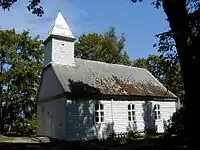Mērsrags
Mērsrags (German: Markgrafen) is a small harbor town in Latvia located on the west coast of the Gulf of Riga, beside Lake Engure and surrounded by extensive woodlands. The total area of the Mērsrags municipality is 109 km2 (10896.2 ha). 63.7% of this area is woodland and Lake Engure covers 20.4%. The coastline is about 12 km. long. The town center is some 42 km from Talsi, the main city of the area, and some 95 km. from the capital, Riga.

Mērsrags had a population of 1986 in June 2008.
Many types of landscape can be seen; seaside, lake reservation, everglades, lagoons, the bed of the dried-up Litorīnas lake (Litorīnas ezers), the sand dune forest, and rural and urban landscapes.
History
The earliest information about Mērsrags is from the 15th century, when it was a small fishing hamlet beside the Gulf of Riga. There are many stories and myths about Mērsrags. Pirates, who lured ships ashore and plundered them, used to live here. During the ducal period, there was a large production of soap.
In 1842 a canal was dug from the north end of Lake Engure to the sea and in 1843 Mērsrags began to develop. In 1880 a lighthouse had been completed and the first ship was launched from the dockyard. Altogether 22 sailing ships were built in Mērsrags. Between 1860 and 1915, 66 sailing ships were built in Upesgrīva village.
Until 1918, Mērsrags village and Upesgrīva village belonged to the parish of the Engure manor but, in 1918, Mērsrags became a separate parish. Likewise in 1926 Upesgrīva became a separate parish.
In 1926 a narrow-gauge railway came to Mērsrags and in 1927 the port was built to satisfy the needs of fishing boats and shipping.
In the 1960s the development of the fish farm collective resulted in a great increase in the production of fish and canned products. The first block of flats and a distant steam heating plant were built. A new fish processing plant was constructed as well as a net repair shop and an engineering workshop. The village roads were repaired and asphalted. Fishing remains an important aspect of the economy, with smoked fish being one of the local specialties.[1]
Sights and attractions
The area has a developed infrastructure for tourism, especially for anglers and birdwatchers.[2]
- Lake Engure, an important stopping place for migratory birds, attracts many birdwatchers and Mērsrags is an excellent place to observe wading birds.[3] The village offers access to the lake's northern shore, where a birdwatching tower is located about 5 km from the town.[4]
- The Mērsrags canal (dug in 1842-1843) is about 4 km. long and connects Lake Engure to the sea.
- Museum - The Peoples House (Saieta Names - latv.). The building is from 1872 and contains an exhibition about life and conditions in Mērsrags and its surroundings at the beginning of the 20th century. There are many relics, tools and items from the houses of the period.
- Mērsrags lighthouse,[1] built in 1874.
- Mērsrags Lutheran Church, built in 1809, is one of the oldest wooden churches in the country.
The church contains several preserved cultural monuments. Located in the old churchyard.
References
- Könnecke, Jochen (2009). Lettland (in German). DuMont Reiseverlag. p. 200. ISBN 9783770172344. Retrieved 15 March 2014.
- Hagemann, Volker (2006). Lettland entdecken: unterwegs im Herzen des Baltikums (in German). Trescher Verlag. p. 243. ISBN 9783897940642.
- Gorman, Gerard (2006). Birding in Eastern Europe. WildSounds. p. 136. ISBN 9781898665076.
- Bousfield, Jonathan (2004). Baltic States. Rough Guides. p. 235. ISBN 9781858288406.